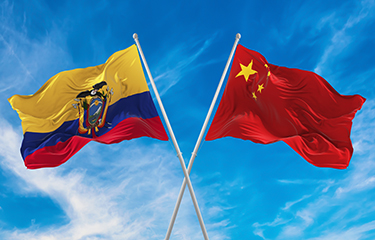Seafood trade experts remain divided on the ultimate impact of any free trade deal between China and Ecuador for the shrimp trade.
With rumors circulating the deal will be inked before the end of 2022, the impact of zero-tariff access could be a driver of Ecuadorian shrimp prices by unleashing Chinese demand, according to general manager of Bangkok, Thailand-based seafood trader Siam Canadian Group's Guangzhou office Landy Chow.
“It will push up the Ecuadorian shrimp price,” Chow told SeafoodSource.
However, Chow said a loosening of China’s inspection regime for imported containers – also expected by the end of the year, as part of an easing of China’s zero-COVID policy – will have an even bigger stimulative impact on seafood sales in the country.
“Chinese buying could push up the raw material price in Ecuador, because the demand will go up if China totally lifts the inspection,” he said.
Rabobank Senior Seafood Analyst Gorjan Nikolik said a free-trade agreement would be “significant” for Ecuador, but noted the South American country is already a significant supplier of shrimp to China.
“We are talking about huge volumes. Ecuador exports are once again over 50 percent dependent on China and China’s shrimp imports are now 60 percent from Ecuador,” he told SeafoodSource.
The impact of China’s potential elimination of tariffs on Ecuadorian shrimp is further blunted by the fact that Indonesia and Vietnam already have tariff-free access through the China-ASEAN free trade agreement, and also have a freight advantage in supplying China, Nikolik said.
“The tariff disadvantage is small compared to other disadvantages faced by Asian producers, like biological issues, but it adds up, with these other costs making it much less likely for the Asian producers to capture market share from Ecuador in China,” he said.
Asian producers need to focus less on processed products, “which is not their strength relative to Ecuador,” Nikolik said. Meanwhile, Ecuador has grown its shrimp output much faster than Asian peers. Production in India, Indonesia, and Vietnam averaged 7 to 8 percent annually, whereas Ecuador’s shrimp has grown by up to 30 percent in recent years. Aquaculture experts have suggested future growth depends less on increasing acreage and more on improving production efficiencies.
Nikolik said the question is whether Ecuador will choose to focus further on supplying rapidly growing U.S. demand, the strongest growth market for shrimp over the past two years, where it has a freight advantage. Ecuador’s shrimp exports to North America rose 56 percent in 2021, while its shipments to Asia rose 11 percent, and shrimp sales to Europe rose by 30 percent year-on-year – though those figures are influenced by low bases set during the COVID-driven slumps in consumption.
Ultimately, the impact of a China-Ecuador FTA will depend on how much and how quickly China’s economy reopens through the tail-end of the COVID pandemic crisis. There has been speculation that China will taper its zero-COVID policy in the wake the Chinese Communist Party offering Chinese President Xi Jinping an unprecedented third term. However, on 16 October, Xi defended the policy in a speech in advance of the Communist Party Congress, making a reversal or easing less likely.
China’s foodservice sector has been battered by the zero-COVID policy, and seafood importers have faced impediments from enhanced food safety protocols at China’s ports. Additionally, China has issued temporary bans on seafood companies determined to have sent product or packaging containing traces of the novel coronavirus into China.
More broadly, China’s economy is enduring a slowdown in its previously red-hot real estate market, which drove much of the country’s growth over the previous five years. In 2022, China’s GDP growth will fall behind the Asian average for the first time in decades, according to World Bank projections.
Global shrimp output will go from 5 million metric tons (MT) in 2022 to 7 million MT in 2030, Nikolik predicted. Ecuador produced 1 million MT in 2021, and it hopes to produce 5 million MT by 2025, but expert opinions remain divided as to whether the country can sustainability hit that target.
Even if Ecuador’s farmed shrimp sector benefits from a FTA with China, it could hurt other parts of Ecuador’s seafood sector and general economy, given that closer ties with China often come with strings attached, according to Eduardo Pucci, director of Organizacion para la Protección de los Recursos del Atlántico Sur (OPRAS), also known as the Organization for the Protection of Resources in the Southwest Atlantic.
The organization’s mission is to push for improvements in regional fisheries management, and it has called illegal fishing by Chinese vessels a threat to global food security and the fishing economies in the countries bordering the Southern Atlantic Ocean. Pucci told SeafoodSource Ecuadorian authorities have in the past been unwilling to openly criticize the misbehavior of Chinese fishing vessels due to diplomatic pressure.
“The case of Ecuador is an example of how the bilateral relationship between countries can prevent or deter concrete actions against infractions by vessels of the trading partner,” Pucci said. “This phenomenon of useless submission to the geopolitical or ideological relationship leaves the fishing of the coastal country in really bad condition.”
Photo courtesy of Maxim Studio/Shutterstock







